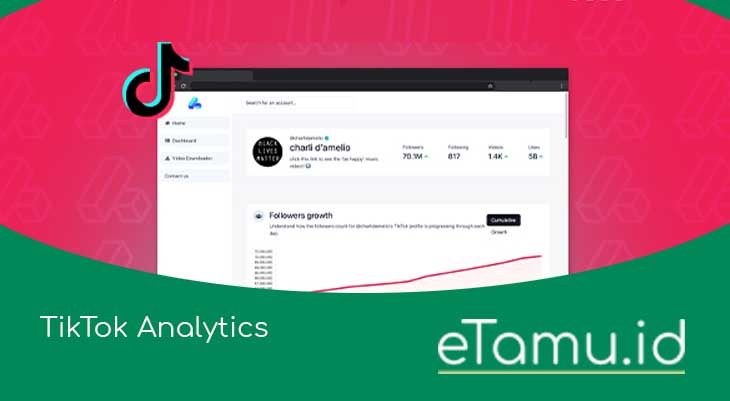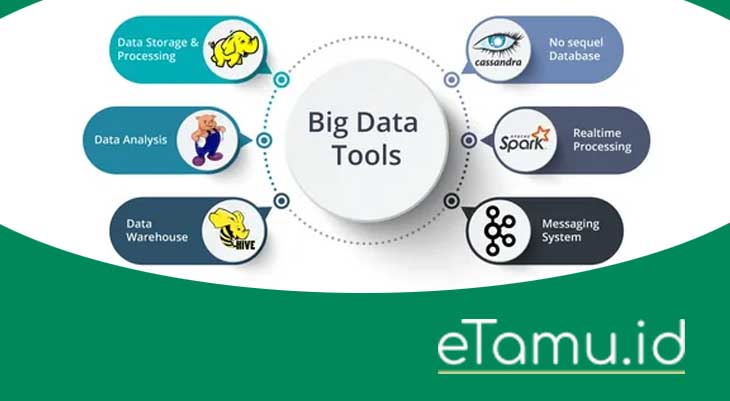eTamu.id – Big Data Analysis: Today, thousands of companies collect and store big data about their customers’ behavior, assortment, production status and other things that are important for business.
But in order to make informed decisions based on data, it is not enough just to collect them – you also need competent analysis. Let’s take a look at what big data analysis includes and what tools can be used for this.
What is big data analytics?
There is no clear definition of what data is considered large. There is no volume limit after which normal data becomes large. But usually we are talking about at least hundreds of gigabytes and hundreds of thousands of rows in databases.
Even more big data, as a rule, is regularly replenished, updated and changed, that is, it is not only stored, but also actively collected. So, we have collected big data and stored it. But in this form, it is just a collection of information that is not capable of bringing any benefit.
To be useful, it is necessary to analyze big data – to structure and process them according to special algorithms in order to draw certain conclusions. For example, we have a hypermarket where people buy certain products.
Big data is the information about purchases: what kind of goods people take, how often, in what quantities. Big data analysis is the study of this information in order to understand which products should be purchased more and which should be removed from the assortment altogether.
That is, in this situation, the analysis of big data involves the study of information about products in order to obtain results that can help the company in development.
Collection and storage of big data
There are many sources of big data for further work. For example:
- User behavior statistics on the site and in the application. Which pages they visit, how long they choose a product, which sections they study the most carefully.
- Sales data from cash registers and from CRM. What exactly and how much people buy.
- Information from sensors on the equipment. How the machines work in the workshop, what temperature is maintained in the room, what channels a person turns on on a smart TV.
- Social surveys. Data on marital status, age, food preferences, etc.
- Data from medical records. Information about the state of health of patients.
- Recordings from surveillance cameras. Age and gender of people, their approximate flow at different times of the day, routes around the trading floor.
- Composite information from different databases. We take several databases with “small” data and collect everything in one place, turning the data into large ones.
Once collected, the data needs to be stored somewhere for later analysis. There are three groups of storage spaces.
Databases (DB)
They are used to store both small and large data. The databases store clearly structured data, sorted into shelves. Data from databases is easier to analyze, but for storage they must first be cleaned and structured.
This is time consuming and can result in the loss of data that seems meaningless for now, but may be useful in the future.
To store big data, they usually use:
- Classic relational databases: MySQL, PostgreSQL, Oracle. They are reliable, but do not scale well, so they are not suitable for huge datasets that are updated frequently.
- Non-relational databases: MongoDB, Redis. Such databases are less reliable, but much more flexible.
Data store
This is a complex storage system of several databases and tools for processing and structuring them. It often also includes services for analyzing data and visualizing it for users. Greenplum, ClickHouse are often used to build data warehouses.
Data lake
This is a large repository, which contains a lot of “raw”, unstructured information. You can upload any data there, so that later it can be extracted, analyzed and used in business. It is more difficult to analyze them later, but when loading, no analysis and structuring is needed.
Data lakes are usually built using Hadoop. Often lakes are used in conjunction with storage or databases. First, all data is loaded into the lake, and then it is extracted from it according to certain criteria, structured and placed in a storage or database.
Technologies for analyzing and using big data
The main task of big data analysis is to help businesses do the right thing and automate certain processes. To do this, there are different methods of using and working with big data.
Mixing and Integrating Data
Big data is often collected from many different sources. At the same time, it is not always possible to upload them to a single database: often the data is heterogeneous and cannot be brought to a general form.
In this case, integration technology is used. It is both data processing and data analysis. To do this, all heterogeneous information is brought to a single format. Data is supplemented and verified: redundant data is removed, missing ones are loaded from other sources.
Often, even after that, certain conclusions can already be drawn from the data. Traditionally, data integration uses ETL processes – extract, transform, and load. Based on these processes, ETL systems are built.
Statistical Analysis
Statistics is the calculation of data according to certain criteria with the output of a specific result of data processing as a percentage. Statistics works best on big data, because the larger the sample, the more reliable the result.
When analyzing big data, you can consider:
- Simple interest, such as loyalty share.
- Average values of data from different groups, such as the average check for different categories of customers.
- Correlation, to calculate how changing one data affects others. For example, how does a customer’s age affect their purchasing power.
As well as some other indicators – depending on the needs of the business.
In the Data Analyst Workshop course, we teach students the basics of big data analysis, working with databases and data warehouses, Python programming, and other skills necessary for comprehensive big data analysis.
Machine Learning and Neural Networks
Big data can be used to build automated systems capable of making decisions on their own. In its simplest form, these are chatbots that can recognize user responses. In the complex – large distributed systems for managing purchases or production.
For such systems to work, they need well-established patterns of behavior. These patterns are drawn just from working with big data. The system looks at how the data has changed in the past, and based on this, acts in the present. Such systems are called neural networks.
In the learning process, neural networks can be taught to analyze big data. For example, neural networks can be fed thousands of photographs of women and men.
And then she will learn to determine the gender from a photo or video, which makes it possible to use it to classify the behavior of buyers.
Predictive Analytics
It is making predictions based on data. For example, we look at the behavior of buyers over the past year and can guess what will be the demand for specific products on a particular day. Or determine which parameters affect the behavior of clients.
Predictive analytics is used to predict currency fluctuations, customer behavior, delivery time of goods in logistics, financial performance of companies. For predictive analytics, big data is scrutinized and then correlated and plotted to predict how things will turn out in the future.
Simulation Modeling
Predictive analytics helps predict what will happen if nothing changes and the system continues to exist in the same data. Modeling helps answer the question: “What if?..”
To do this, we build the most accurate model of the situation on the basis of big data, and then change the parameters in it: we increase the price of the product, increase the flow of customers, change the size of the manufactured product. machine parts.
The model responds to this and shows what will happen: how profit will change, what will happen to customer loyalty, whether the production speed will decrease.
Big Data Analytics Tools
Most often, scripts and programs written in Python are used to analyze big data. To work collaboratively and efficiently, these scripts and programs are written in special interactive environments – Jupiter Notebook, Kaggle and Google Collab.
These environments allow you to upload data, use machine learning and neural networks, and collect statistics.
Power BI and Tableau are used to visualize the results of data analysis. They allow you to build visual charts, graphs and tables to demonstrate the results of analytics to those who do not understand data analysis deeply enough.
There are also special tools and frameworks for processing big data using different technologies: Hadoop, Caffe and others. They are used for machine learning and complex data analysis, choosing a tool depending on the technologies used in the company and business tasks.
Professions in the field of data analysis
Data Scientist
This profession is in many ways similar to data analyst – sometimes they are given the same tasks in the market, especially at the start of a junior job.
At a higher level, data scientists work more with big data analysis methods such as models, neural networks, and visualization, while analysts use statistical analysis and other mathematical methods.
But this is not a mandatory rule: analysts often work with visualization, data scientists often work with statistics. It depends on the tasks that the business defines.
Data Engineer
This person builds the very systems that data analysts and data scientists use. He deploys storages, sets up data cleaning and analysis systems, gives data to analysts on demand, and makes sure that everything works fine.
Data Analyst
This is exactly the person who is engaged in the analysis of big data. Businesses come to him with questions, for example: “Which product should we exclude from the assortment?”, “What determines the average time of admission to the hospital?”, “Which customers buy the most?”.
The analyst takes the already collected data, analyzes it using special technologies and provides a report. And already on the basis of this report, managers and leaders make business decisions.
Related post:
- Top 10 Best Big Data Tools and The 5Vs to Define the Tool
- How Big Data Helps Companies Grow Faster! Here is The Fact
- Big Data Marketing: The Role in Developing a Company’s Strategy
- Social Media Strategies for Nonprofits Organization Marketing
- Content Intelligence: Improve Quality of Content Marketing Strategy
- 10 Content Marketing Tools that Marketers Need to Master
- Pivot Glass Doors A Stylish Choice - June 2, 2025
- Mountain Modern Cabin A Stylish Retreat - May 6, 2025
- Modern Loft House A Stylish Home - May 6, 2025










